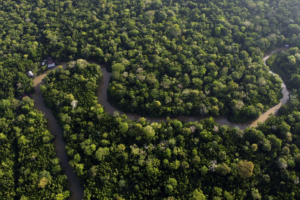‘One woman heard tree branches snapping and jumped out of bed – just in time to see her mattress float away as the back half of her house melted into the darkness’
I started my Shifting Sands series seven years ago to look at how the world is running out of usable sand. It’s the next big resource crisis. I’m from Singapore, the world’s biggest importer of sand per capita, due to the scale of its land reclamation. That was the starting point of what I had initially mapped out as a global project, investigating the extraction of and uses of sand, its consequences and alternatives.
I photographed in Singapore, China, Malaysia and Vietnam. The Mekong Delta in Vietnam is experiencing rapid erosion due to large-scale sand mining and China damming the river upstream. I went to a number of villages with researchers. We went to the commune of Hiep Phuoc, southeast of Saigon, where this picture was made, just five days after a number of villagers – including tea-seller Nguyen Thi Hong, 45, who appears in this image – had lost their homes.
One woman, a seamstress, described how she heard tree branches snapping loudly at midnight and jumped out of bed, just in time to see her mattress float away, as the back half of her house melted into the river, into the darkness. I recorded her testimony and those of several other women who had lost their ancestral land to that landslide. I wrote a script based on the testimonies, narrated by Vietnamese poet Khai Don, as a voiceover in the VR piece I made with this work for a show in Berlin last year. In it, the viewer is placed in an abstract world with swirling sand and water, transported to a site of erosion.
By the time I got there, Ms Nguyen had already set up a new tea stand in another spot. She had lost her property, like the others who had houses along the river. I tried not to show her as a victim, but I did want to visualise the loss. This is among the more literal pictures in the series – the rest of Shifting Sands is mostly abstract aerial and landscape photographs. I think it works as a documentary image, but I have also started to question the efficacy of my documentary photography in recent years.
I’m now examining the evidential, the document. For the past decade, I’ve been working with colonial archives, for a project on the anti-colonial war in British Malaya, what is now Malaysia and Singapore. My paternal grandfather was in the anti-colonial movement there, and early on in the conflict, which ran from 1948 to 1960, he was deported to mainland China. In fact, more than 30,000 Malayans were deported by the British during the Malayan Emergency, yet this aspect of the Malayan war remains under-researched, under-told.
My grandfather was executed by the rival Nationalists shortly after arriving in southern China – in mid 1949, as China was in the final months of its civil war. He died for socialism, and his five children in anti-communist Malaya/Malaysia were told never to speak about him again. His name is not on my grandmother’s gravestone. There was silence for six decades – until I was in my early 30s. I was working as a foreign correspondent in Beijing, trying to figure out my relationship to mainland China as a Singaporean, when I remembered that my dad had mentioned grandad was buried in southern China. When I quit my job at the newspaper in 2010, I decided to find out what his story was. It blasted open a 13-year project: One Day We’ll Understand.
This has been shown as photo and film installations, glass works, and books. A video work from it is showing at the main exhibition at the Venice Biennale. I’m also making a theatre performance from it, which premieres in Singapore in August. This is not just about my family history – it’s also to do with the fact that Malaya is a largely forgotten war despite its outsized importance in the history of warfare. It is where Agent Orange and strategies of ring-fencing rural populations were piloted, then applied to other wars including Vietnam, Iraq and Afghanistan.
The project also asks broader questions about the archive: what’s in and what’s out, and how we can interrupt its trauma and violence? How do we remake this representation of the past we’ve inherited, to hand on to the future?

Sim Chi Yin’s CV
Born: 1978, Singapore
Trained: BA in History and MSc in History of International Relations, London School of Economics and Political Science, University of London, PhD candidate at King’s College London, self-taught photographer.
Influences: “Saidiya Hartman, Amar Kanwar, John Akomfrah and other strong artist mothers”
High point: “So far, this year’s Venice Biennale participation; but still working on it: I check in myself every six months or so, and if I feel like I’ve grown in my work, I’m grateful. I can only be as ‘good’ as I can get to myself.”
Low point: “When I had my right thumb ligament ripped by North Korean women migrant workers on the China-North Korean border in 2015. And when I heard, ‘Her work is not as good now after she’s had a child,’ in a photographers’ meeting in 2021. That’s total rubbish of course. I’m excited about being an artist-mum: my child has made his way into my work now and I think I have not yet made my best work.”
Top tip: “Learn as many skills as you can outside of photography, have deep research interests, and have your own drum beat – ignore the naysayers.”
• features in See/Change: Art Collection Deutsche Börse @25, at Photo London, Somerset House, 15-19 May
I hope you appreciated this article. Before you move on, I wa




